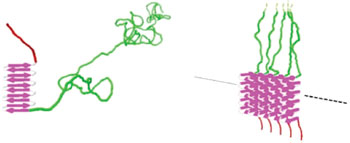Synthetic Virus Designed to Enhance Delivery of New Generation of Pharmaceutical Agents
By LabMedica International staff writers
Posted on 11 Sep 2014
Dutch scientists have effectively developed an artificial virus that may be used for the delivery of a new generation of pharmaceutical agents, consisting of large biomolecules, by packaging them in a natural manner and delivering them to diseased cells. The artificial virus was developed according to a new theoretic determination of how viruses work, according to the researchers.Posted on 11 Sep 2014
The findings were published in the August 31, 2014, issue of the journal Nature Nanotechnology. Specifically, the researchers, from Wageningen University (The Netherlands), along with colleagues from the University of Leiden (The Netherlands), Eindhoven University of Technology (The Netherlands), and Radboud University Nijmegen (The Netherlands) think that the artificial virus technology could be useful for gene therapy.

Image: Design of the minimal viral coat protein C-Sn-B (Photo courtesy of Wageningen University).
Standard drugs consist of comparatively small molecules that typically arrive at the desired location without too much difficulty. This is more difficult for newer types of drugs that are being developed; these are comprised of large biomolecules such as proteins and genetic material (i.e., DNA and RNA). For example, to use DNA in gene therapy, the molecule must be delivered to diseased cells in its totality to be effective. However, DNA is inherently incapable of penetrating cells and is rapidly degraded. Therefore natural viruses that have been rendered harmless are used as so-called vectors. These can enter cells efficiently and deliver the therapeutic DNA or RNA molecules.
However, the process of rendering natural viruses harmless still requires improvement. Unwanted side effects have been a hurdle. Therefore, research is also being conducted into alternative virus-like vectors based on synthetic molecules. Regrettably, these have been less effective because it is difficult to precisely duplicate the many behaviors used by viruses. A first important step in mimicking viruses is the effective packaging of individual DNA molecules with a protective coat of smaller molecules. This sounds easier than it is, the researchers reported. Up to now, packing individual DNA molecules with a protective coating of synthetic molecules has not yet been accomplished.
The researchers decided to design and construct artificial viral coat proteins, instead of using synthetic chemistry to coat individual DNA molecules. As part of their study, they used recent theoretic insights into the key aspects of the process of packaging genetic material by natural viral coat proteins. The researchers converted each of these key features into various protein blocks with simple structures. The amino acid sequence of the protein blocks was inspired by natural proteins such as collagen and silk. Artificial viral coat proteins designed in this manner were produced using the natural processes of yeast cells. When the proteins were combined with DNA, they spontaneously formed a highly protective protein coat around each DNA molecule, thus creating artificial viruses. The formation process of the artificial viruses is similar in many ways to that of natural viruses, such as the tobacco mosaic virus, which served as a model for the artificial virus.
This first generation of artificial viruses was found to be as effective as the current methods for delivering DNA to host cells based on synthetic molecules. But the great precision by which DNA molecules are packaged in the artificial virus offers many possibilities to now also build in other virus tricks, the researchers write. In the future, these techniques can hopefully lead to safe and effective approaches for delivering new generations of pharmaceuticals, especially in gene therapy. Moreover, these artificial viruses can also be developed for the many other applications in which viruses are now being used in fields such as biotechnology and nanotechnology.
The artificial viral proteins were designed and produced by scientists of Wageningen UR (University & Research Center). They worked in collaboration with colleagues from Eindhoven University of Technology and Leiden University, who provided contributions based on the theory of spontaneous formation of virus particles, and helped to visualize the resulting artificial virus particles, and partners from Radboud University Nijmegen, who assessed the penetration of the artificial virus particles into living cells.
Related Links:
Wageningen University
University of Leiden
Radboud University Nijmegen














